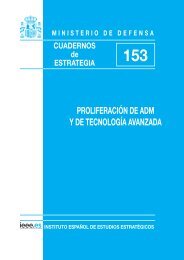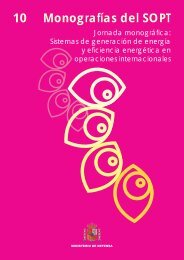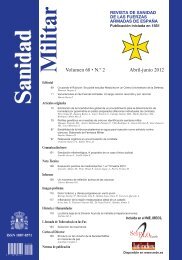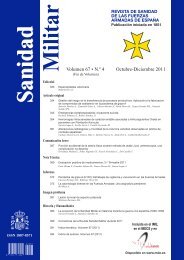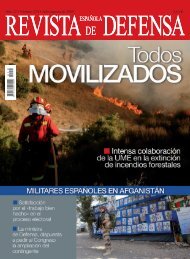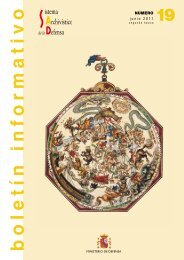Sanidad Militar - Portal de Cultura de Defensa - Ministerio de Defensa
Sanidad Militar - Portal de Cultura de Defensa - Ministerio de Defensa
Sanidad Militar - Portal de Cultura de Defensa - Ministerio de Defensa
You also want an ePaper? Increase the reach of your titles
YUMPU automatically turns print PDFs into web optimized ePapers that Google loves.
ARTÍCULOS ORIGINALES<br />
Gestión <strong>de</strong>l riesgo en la transferencia <strong>de</strong> procesos<br />
productivos. Aplicación a la fabricación <strong>de</strong> comprimidos<br />
<strong>de</strong> oseltamivir en la pan<strong>de</strong>mia <strong>de</strong> gripe A<br />
Juberías Sánchez A. 1 , Zamanillo Sainz A. 2 , Cabrera Merino JI. 1 , Verón Moros M. 3 , Urquía Gran<strong>de</strong> MªL. 4 ,<br />
Gonzalo Salado MªL. 5<br />
Sanid. mil. 2011; 67 (4): 334-344; ISSN: 1887-8571<br />
RESUMEN<br />
Introducción: La gestión <strong>de</strong> riesgos aplicada a la industria farmacéutica, a través <strong>de</strong> su i<strong>de</strong>ntificación, valoración y control, es una herramienta útil<br />
para garantizar la calidad <strong>de</strong>l medicamento. La <strong>de</strong>claración por la Organización Mundial <strong>de</strong> la Salud en el año 2.009, <strong>de</strong> la pan<strong>de</strong>mia provocada<br />
por el virus <strong>de</strong> la influenza H1N1, origina la necesidad <strong>de</strong> transformar en medicamento parte <strong>de</strong> las reservas estratégicas <strong>de</strong> fosfato <strong>de</strong> oseltamivir,<br />
pertenecientes al <strong>Ministerio</strong> <strong>de</strong> <strong>Sanidad</strong> y Política Social y a las Comunida<strong>de</strong>s Autónomas. Debido a esta circunstancia, se dibuja, un nuevo escenario<br />
<strong>de</strong> actuación <strong>de</strong> los Servicios Farmacéuticos <strong>de</strong> la <strong>Defensa</strong>, bajo la tutela <strong>de</strong> la Agencia Española <strong>de</strong> Medicamentos y Productos Sanitarios.<br />
Objetivo: La aplicación <strong>de</strong> los principios <strong>de</strong> gestión <strong>de</strong>l riesgo, posibilitará una rápida adaptación <strong>de</strong> la tecnología necesaria para la fabricación <strong>de</strong><br />
comprimidos <strong>de</strong> fosfato <strong>de</strong> oseltamivir. Se realiza la evaluación <strong>de</strong>l riesgo asociado a las diversas fases <strong>de</strong>l proceso y se establecen <strong>de</strong>terminados parámetros<br />
<strong>de</strong> control sobre la calidad final <strong>de</strong>l medicamento producido. Material y Método: Se aplica el Análisis modal <strong>de</strong> fallos modales y efectos<br />
y su criticidad para establecer y evaluar los posibles riesgos <strong>de</strong>l proceso productivo y se efectúan las correspondientes <strong>de</strong>terminaciones analíticas<br />
referidas a la calidad <strong>de</strong>l producto obtenido. Resultados: Los riesgos asociados al proceso son establecidos y evaluados. La media <strong>de</strong>l contenido<br />
<strong>de</strong> los comprimidos y <strong>de</strong>l porcentaje <strong>de</strong> disolución <strong>de</strong> los mismos a los 20 minutos es <strong>de</strong> 101,9 % y 102,5% respectivamente, cumpliendo todos<br />
los lotes fabricados el ensayo <strong>de</strong> evaluación <strong>de</strong> la contaminación microbiológica. Los resultados obtenidos para los lotes en las variables objeto <strong>de</strong><br />
validación <strong>de</strong>l proceso (peso <strong>de</strong> los comprimidos y porcentajes <strong>de</strong> principio activo, <strong>de</strong> homogeneidad <strong>de</strong> la mezcla y <strong>de</strong> disolución) cumplen las<br />
especificaciones establecidas y no se aprecian diferencias significativas entre los diferentes lotes (p>0,05). Conclusiones: Los resultados obtenidos<br />
corroboran el éxito <strong>de</strong> la transferencia <strong>de</strong>l proceso productivo <strong>de</strong> comprimidos <strong>de</strong> fosfato <strong>de</strong> oseltamivir a las instalaciones y equipos disponibles, así<br />
como la consecución <strong>de</strong> un proceso robusto y repetitivo, que proporciona un medicamento ajustado a las especificaciones <strong>de</strong> calidad establecidas.<br />
PALABRAS CLAVE: Gestión <strong>de</strong>l riesgo. Transferencia <strong>de</strong> procesos. Adaptación equipos. Antivirales. Fosfato <strong>de</strong> Oseltamivir.<br />
Risk management in the transfer of manufacturing processes. Application to the manufacturing of oseltamivir tablets in the swine<br />
flu pan<strong>de</strong>mic<br />
SUMMARY:<br />
Introduction: Risks management applied to the pharmaceutical industry, through their i<strong>de</strong>ntification, evaluation and control, is a useful tool<br />
to guarantee drug quality. The <strong>de</strong>claration of swine flu H1N1 pan<strong>de</strong>mic in 2009 by the World Health Organization, resulted in the need to<br />
transform into tablets part of the strategic reserves of oseltamivir phosphate of the Ministry of Health and Social Policy and the Autonomous<br />
Communities. This situation led to a change in the activity of the Defense Pharmaceutical Service un<strong>de</strong>r the auspices of the Spanish Agency<br />
for Medicines and Health Products. Objective: Applying the principles of risk management makes possible a fast adaptation of the technology<br />
to manufacture the oseltamivir phosphate tablets. We evaluated the risk associated to the different stages of the process and established particular<br />
control parameters of the final quality of the product. Materials and Methods: We applied the modal analysis of failures and effects<br />
and their criticality to establish and evaluate possible risks of the manufacturing process and carried out the necessary lab tests to check the<br />
quality of the product. Results: The risks associated to the process are established and evaluated. The average tablet content and the dissolution<br />
percentage at 20 minutes is 101.9% and 102.5%, respectively. All batches passed the microbiological contamination control. The results<br />
obtained for all batches in the validating variables of the process (weight of the tablets, percentages of active principle, homogeneity of the mix<br />
and dissolution) fulfill the required specifications and there are not significant differences among the different batches (p>0,05). Conclusions:<br />
The results confirm the successful transfer of the manufacturing process of the oseltamivir phosphate tablets to the facilities and equipment<br />
available, as well as the achievement of a robust and repetitive process that provi<strong>de</strong>s a drug fulfilling the required quality specifications.<br />
KEYWORDS: Risk management, Process transfer, Equipment adaptation, Antivirals, Oseltamivir phosphate.<br />
1<br />
Tcol. Farmacéutico. Centro <strong>Militar</strong> <strong>de</strong> Farmacia <strong>de</strong> la <strong>Defensa</strong>-Burgos. España.<br />
2<br />
Tcol. Farmacéutico. Inspección General <strong>de</strong> <strong>Sanidad</strong>. Madrid. España.<br />
3<br />
Lda. en Farmacia. Centro <strong>Militar</strong> <strong>de</strong> Farmacia <strong>de</strong> la <strong>Defensa</strong>. Madrid. España.<br />
4<br />
Dra. en Farmacia. Centro <strong>Militar</strong> <strong>de</strong> Farmacia <strong>de</strong> la <strong>Defensa</strong>-Madrid. España.<br />
5<br />
Cte. Farmacéutico. Centro <strong>Militar</strong> <strong>de</strong> Farmacia <strong>de</strong> la <strong>Defensa</strong>-Madrid. España.<br />
Dirección para correspon<strong>de</strong>ncia: A. Juberías Sánchez. Centro <strong>Militar</strong> <strong>de</strong> Farmacia <strong>de</strong> la<br />
<strong>Defensa</strong>. Paseo <strong>de</strong> las Fuentecillas, s/n. 09001 Burgos. ajubsan@oc.m<strong>de</strong>.es<br />
Recibido: 28 <strong>de</strong> junio <strong>de</strong> 2010<br />
Aceptado: 24 <strong>de</strong> marzo <strong>de</strong> 2011<br />
INTRODUCCIÓN Y ANTECEDENTES<br />
Gestión <strong>de</strong> riesgos y producción farmacéutica<br />
La gestión <strong>de</strong>l riesgo se configura como una herramienta orientada<br />
a <strong>de</strong>scubrir la probabilidad <strong>de</strong> aparición <strong>de</strong> un riesgo y a valorar la<br />
severidad <strong>de</strong> aquél; esto es, la capacidad que presenta el riesgo <strong>de</strong> producir<br />
un daño, mediante la aplicación <strong>de</strong> una <strong>de</strong>terminada sistemática 1 .<br />
334 Sanid. mil. 2011; 67 (4)









